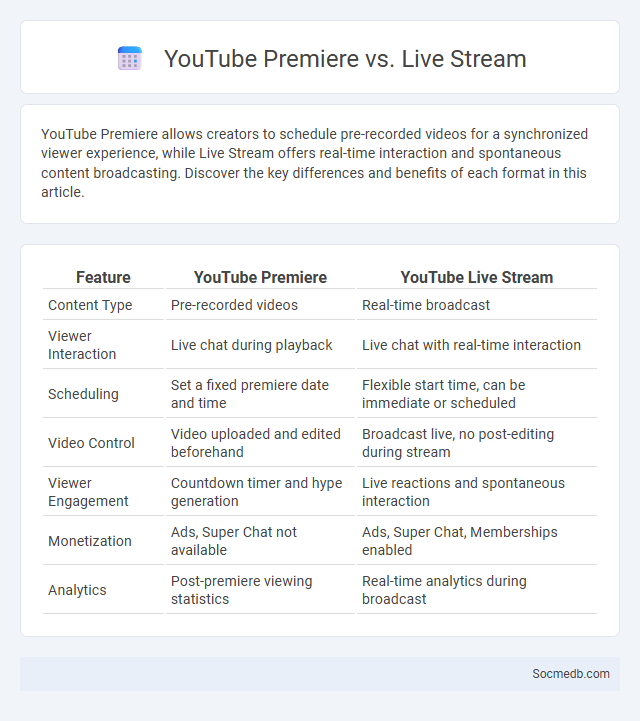
Photo illustration: YouTube Premiere vs Live Stream
YouTube Premiere allows creators to schedule pre-recorded videos for a synchronized viewer experience, while Live Stream offers real-time interaction and spontaneous content broadcasting. Discover the key differences and benefits of each format in this article.
Table of Comparison
| Feature | YouTube Premiere | YouTube Live Stream |
|---|---|---|
| Content Type | Pre-recorded videos | Real-time broadcast |
| Viewer Interaction | Live chat during playback | Live chat with real-time interaction |
| Scheduling | Set a fixed premiere date and time | Flexible start time, can be immediate or scheduled |
| Video Control | Video uploaded and edited beforehand | Broadcast live, no post-editing during stream |
| Viewer Engagement | Countdown timer and hype generation | Live reactions and spontaneous interaction |
| Monetization | Ads, Super Chat not available | Ads, Super Chat, Memberships enabled |
| Analytics | Post-premiere viewing statistics | Real-time analytics during broadcast |
Introduction to YouTube Premiere, Live Stream, and Standard Premiere
YouTube Premiere allows creators to schedule and debut pre-recorded videos with a live chat feature, creating real-time viewer engagement. Live Stream on YouTube enables broadcasting in real-time, offering interactive elements such as instant chat, Q&A, and real-time feedback. Standard Premiere acts as a hybrid, presenting pre-recorded content as a live event, fostering audience anticipation while maintaining content control and scheduled timing.
Key Features of YouTube Premiere
YouTube Premiere allows creators to schedule and debut videos with a personalized watch page, fostering real-time interaction through live chat during the premiere. This feature enhances audience engagement by creating anticipation and enabling immediate feedback, making the viewing experience more communal. Premiere also includes customizable countdown timers and analytics to track viewer behavior and optimize future content strategies.
Key Features of YouTube Live Stream
YouTube Live Stream offers real-time broadcasting with interactive chat, allowing content creators to engage directly with viewers. It supports high-definition video quality and integrates features like Super Chat for monetization and live polls for audience interaction. The platform also provides analytics in real-time to track viewer engagement and optimize streaming strategies effectively.
What is Standard Premiere on YouTube?
Standard Premiere on YouTube is a feature that allows creators to schedule and broadcast a pre-recorded video as a live event, enabling real-time viewer interaction through live chat. This format increases engagement by building anticipation before the video's release and provides an experience similar to watching a live stream. Standard Premieres help creators boost visibility and audience interaction by combining scheduled content drops with live community participation.
Audience Interaction: Premiere vs Live Stream
Audience interaction in social media premiere videos is typically limited to post-viewing comments and reactions, creating a delayed engagement experience. In contrast, live streams facilitate real-time communication, allowing viewers to participate actively through live chat, polls, and instant feedback. This immediacy enhances viewer connection and can increase retention and community building during social media events.
Scheduling and Promotion Capabilities
Effective social media scheduling and promotion capabilities enable you to plan and automate posts across multiple platforms, ensuring consistent engagement with your target audience. Advanced tools provide detailed analytics and audience insights, allowing you to optimize posting times and promotional strategies for maximum reach. Leveraging these features enhances your brand visibility while saving time and improving campaign performance.
Content Types Best Suited for Each Format
Short videos dominate platforms like TikTok and Instagram Reels, driving high engagement through quick, visually compelling storytelling. Carousel posts on Instagram provide an effective way to share multiple images or tips, enhancing user interaction and content depth. LinkedIn favors long-form articles and professional updates, aiding in thought leadership and networking within industry-specific communities.
Monetization Opportunities Compared
Social media platforms offer diverse monetization opportunities, including advertising revenue, influencer partnerships, subscription models, and direct sales through integrated e-commerce features. Platforms like YouTube and Instagram prioritize ad placements and sponsored content, while TikTok emphasizes creator funds and live gift gifting systems for revenue. Emerging platforms also explore subscription-based content and exclusive community memberships to maximize creator earnings.
Analytics and Viewer Engagement
Social media analytics provide crucial insights into audience behavior, allowing businesses to tailor their content strategies for maximum engagement. By tracking metrics such as click-through rates, comments, shares, and time spent on posts, brands can measure viewer interactions and optimize future campaigns. Enhanced viewer engagement through data-driven adjustments boosts brand visibility and strengthens customer loyalty across platforms like Instagram, Facebook, and TikTok.
Choosing the Right Format for Your Channel
Selecting the ideal format for your social media channel hinges on understanding your target audience's preferences and platform algorithms. Video content tends to boost engagement on platforms like Instagram and TikTok, while infographics and carousel posts perform well on LinkedIn for professional audiences. Tailoring content formats to channel-specific trends enhances visibility, user interaction, and overall campaign success.
 socmedb.com
socmedb.com